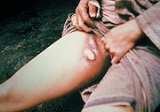coffeym
Boccaccio described the plague thusly:
Not such were they as in the East, where an issue of blood from the nose wasa manifest sign of inevitable death; but in men and women alike it firstbetrayed itself by the emergence of certain tumours in the groin or thearmpits, some of which grew as large as a common apple, others as an egg,some more, some less, which the common folk called gavoccioli. From the two said parts of the body this deadly gavocciolo soon began to propagate and spread itself in all directions indifferently; after which the form of the malady began to change, black spots or livid making their appearance in many
cases on the arm or the thigh or elsewhere, now few and large, now minute and numerous. And as the gavocciolo had been and still was an infallible token of approaching death, such also were these spots on whomsoever they shewed themselves. Which maladies seemed to set entirely at naught both the art of the physician and the virtues of physic; indeed, whether it was that the disorder was of a nature to defy such treatment, or that the physicians were at fault--besides the qualified there was now a multitude both of men
and of women who practised without having received the slightest tincture of medical science--and, being in ignorance of its source, failed to apply the
proper remedies; in either case, not merely were those that recovered few, but almost all within three days from the appearance of the said symptoms, sooner or later, died, and in most cases without any fever or other attendant malady.
Not such were they as in the East, where an issue of blood from the nose wasa manifest sign of inevitable death; but in men and women alike it firstbetrayed itself by the emergence of certain tumours in the groin or thearmpits, some of which grew as large as a common apple, others as an egg,some more, some less, which the common folk called gavoccioli. From the two said parts of the body this deadly gavocciolo soon began to propagate and spread itself in all directions indifferently; after which the form of the malady began to change, black spots or livid making their appearance in many
cases on the arm or the thigh or elsewhere, now few and large, now minute and numerous. And as the gavocciolo had been and still was an infallible token of approaching death, such also were these spots on whomsoever they shewed themselves. Which maladies seemed to set entirely at naught both the art of the physician and the virtues of physic; indeed, whether it was that the disorder was of a nature to defy such treatment, or that the physicians were at fault--besides the qualified there was now a multitude both of men
and of women who practised without having received the slightest tincture of medical science--and, being in ignorance of its source, failed to apply the
proper remedies; in either case, not merely were those that recovered few, but almost all within three days from the appearance of the said symptoms, sooner or later, died, and in most cases without any fever or other attendant malady.


